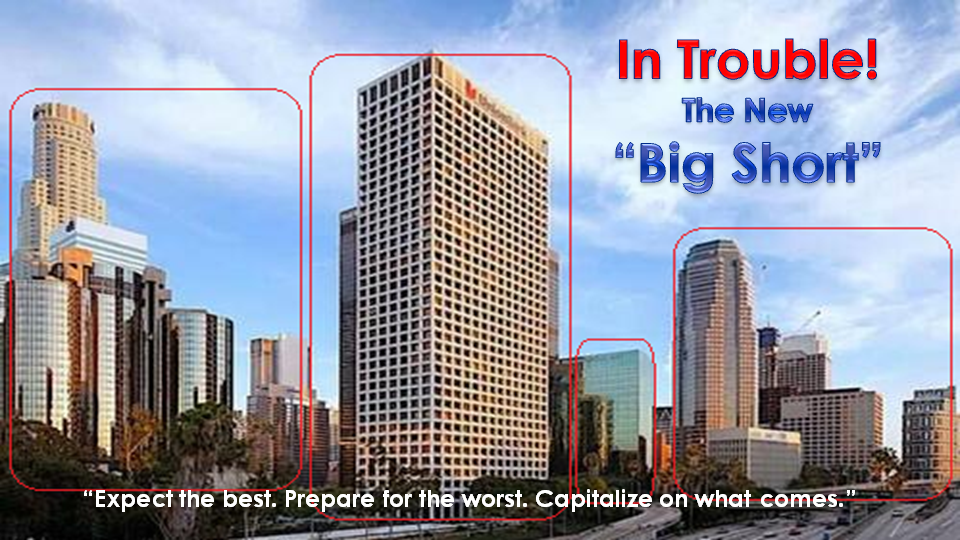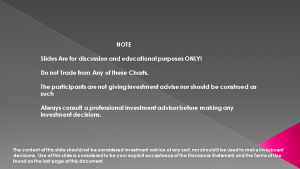IN-DEPTH: TRANSCRIPTION - LONGWave - 03-05-23 - APRIL – IN TROUBLE! – "The New Big Short”?
SLIDE DECK
TRANSCRIPTION
SLIDE 2
Thank you for joining me. I'm Gord Long.
A REMINDER BEFORE WE BEGIN: DO NO NOT TRADE FROM ANY OF THESE SLIDES - they are COMMENTARY for educational and discussion purposes ONLY.
Always consult a professional financial advisor before making any investment decisions.
SLIDE 3
The unfolding financial implosion is not going to continue to be primarily centered on banks!
As the crisis continues to broaden, it is highly likely going to be dominated by other financial institutions such as Insurance Companies, Pensions Plans, REITS, small banks & credit unions and other financial intermediaries as they are all swept into the orbit of tightening credit standards, liquidity shortages, counterparty risk, cash flow and solvency issues.
What do these lenders have in common?
Two things! Assets and collateral values pinned to it:
- US Treasury Bill, Notes and Bonds, and
- Commercial Real Estate or simply CRE.
There is the strong potential for developing waves to be much different and more profound than any previous financial crisis we have yet (or likely to ever) experience to most of us living today!
SLIDE 4
I have written enough lately about Banks, Small Banks & Small Business as well as the US Treasury market. What I haven’t discussed recently however is Commercial Real Estate or the CRE sector is an extension of that same discussion. A very important extension which I haven’t had the space to delve into.
- Commercial Real Estate is a massive ~$21 Trillion US Market.
- Importantly, there are approx. $270B of CRE loans due by end of year and already $3B of defaults in March alone
- Brookfield on a $748M of LA offices loans,
- PIMCO on a portfolio of $1.7B asset backed mortgage notes,
- Blackstone on $562M in Nordic CMBS.
- Problematic small and regional banks caught up in the current whirlwind of action, reaction own around 80% of CRE loans worth around $2.3 trillion,
As expected, now professionals are digging into the details of NAVS, real market-to-markets valuations, net operating incomes, costs of capital as well as falling occupancies and square foot pricing.
THE QUESTION BEING ASKED: About the debt coverage ratio - How are any declines here going to impact cash flows and/or result in higher default rates?
The system seems to have forgotten, after a longer than usual, 14 year cycle……that cycles can happen and down-turns do come. Both are periods of proven under performance for CRE!
To give you some perspective on this I will cover the subjects listed here
SLIDE 5
I warned about all this in 2019. In one article entitled: “The Next Financial Implosion Is Not Going To Be About the Banks!”, published broadly on sites such as Seeking Alpha, Talk Markets and others.
I quote:
“The coming financial implosion is not going to be about the large international banks. It is going to be dominated by Insurance Companies, Pensions Plans, Trusts & Endowments and small banks & credit unions. These are the institutions with the bulk of their invested assets in some form of US commercial real estate!
The potential for this Third Wave is much different and more profound than any previous financial crisis we have yet (or likely to ever) experience!”
“Most fundamentally, the reason for this occurring is:
- The (continuing) De-Industrialized of America and a resulting "gutted middle class" that is now economically "tapped out",
- (Ongoing ) Demographics hav(ing) an older generation that historically starts spending less as well as an overall shrinking working age population,
- The (continuing) impact of the internet and robotics on job destruction.”
SLIDE 6
The current financial turmoil we are experiencing is not simply yet another banking crisis.
It is an asset crisis across a very broad swath of the financial sector – both domestically and internationally.
It is currently about the over $600Bn in unrealized losses on these players US Treasuries holdings, but is quickly becoming about their asset positions in their CRE holdings. Both being core holdings and central to their business models and existence!
SLIDE 7
The health of this sector is fundamental to the entire financial sector. Problems here would have profound impacts on the US Economy overall.
SLIDE 8
Any spillage would be global as foreign investment in US CRE (as shown here on the left) is immense. The world’s two most expensive CRE markets are NY and LA.
This is very similar to Japan when its economic bubble burst in the late 1980’s.
SLIDE 9
In many ways it is like the chicken or egg riddle. Which came first; a banking crisis or a C RE crisis? Though it would appear on the surface to be a banking crisis forces of globalization and Financialization have driven CRE’s to levels of non-affordability & instability without maintaining historic levels of low interest rates and low inflation.
SLIDE 10
This will take time to play out...
... Because this is one of these "trades" for example where people will postpone and avoid as long as possible the "mark-to market" reality.
Small banks have dramatically increased their share of commercial mortgages vs large banks. Now with their deposits fleeing to safety and higher Money Market Fund yields, and their unrealized bond lossess enough to place them into insolvency if priced to market, they can ill afford pricing their CRE holdings down – a simply reality that few can willing accept!
SLIDE 11
The reality unfortunately is getting more pronounced daily! Shown here is VNO over the last 10 years. VNO is an S&P 500 member and one of the largest REITs in the U.S with a particular NYC focus.
Through the end of 2022, the amount outstanding of commercial mortgage loans in the US stood at $5.6 trillion. Over half of this stock sits directly on commercial bank balance sheets, with small banks capturing a much larger share than large banks and including mid-sized banks (i.e. banks with less than $250 billion in assets).
Economists estimate that the combined share of small and mid-sized banks is 80% of the overall stock of commercial mortgage loans. Excluding the securitized CMBS market, banks originated over 40% of commercial mortgage loans in the first half of 2022
SLIDE 12
What does Wall Street see? They were stung pretty hard on Residential Real Estate in 2008 and with this crisis unfolding the charts they are kicking out to their institutional clients is quite remarkable. They last a lot of investor confidence in 2008 and certainly don’t want another repeat ( for their clients or their own assets).
SLIDE 13
I showed this chart of the timeline which unfolded during the 2008 Residential Real Estate Crisis. It took much longer to unfold than many expected.
Our analysis suggests we have the foundations of a major Banking, Pension and Insurance Crisis.
- Certainly there is a high probability this is just the start of a Major Banking Crisis,
- It is still in the 1st inning of a very long crisis,
- Before it’s over there is likely to be many more surprising and unexpected failures, in US & Globally.
- We have a typical Recessionary Cycle …. This one is highly suseptical to quickly getting Out-of-Control due leverage and debt levels, unsound lending standard and sustained levels of mal-investment from frankly “Monetary Mal-Practice”!
alone, with roughly $2.5T in the next 5 year, how many marginal players will not go bust.
We bailout banks but this is a much bigger problem than simply banking! It’s a Financial Industry problem!
SLIDE 14
What we need to pay attention to is the “CRE Waterfall” sequence of events shown here.
- Occupancy Falls,
- Square Foot Rental Price Falls,
- Rent Roll Falls,
- Building Value Falls,
- Reserves Consumed,
- Lender Seeks More Equity to Restore 50% LTV.
- Equity then Walks Away
SLIDE 15
We appear to be about here at the present time but moving very quickly towards the next “Waterfall Level”.
SLIDE 16
As we release this video I read that one of the largest US CRE players has significantly restricted redemptions on its REIT offerings. The redemptions requests surged to $4.5B and were force to restrict it to only $666B.
To make matters worse, this was the fifth consecutive month! Blackstone's $71 billion real estate income trust (BREIT) has restricted redemption withdrawal requests.
SLIDE 17
In Q1, San Francisco’s office-vacancy rate was just reported to have soared to a record 29.5%. This number stood at just 4% prior to the pandemic.
SLIDE 18
When the Covid-19 lockdowns occurred the IMF was so worried about the impact on Global Real Estate it is issued a major warning as part of its regular Financial Stability Report in April of 2021. This schematic was part of it outlining in linkage of financial intermediaries involved and the critical structural channels.
Conceptually, there are three key channels through which a decline in commercial real estate prices interacts with other financial vulnerabilities to affect financial stability.
- SOLVENCY CHANNEL: The first is a bank solvency channel (in the upper middle box), which sets in as banks are exposed to credit risk through their commercial real estate loans, as well as to credit and market risks through their commercial mortgage-backed security holdings. A downturn in the commercial real estate market worsens the credit quality of borrowers by affecting the strength of their income streams and balance sheets. In the event of borrower default or a large drop in commercial mortgage-backed security prices, banks incur losses and their capital positions are weakened, which in turn leads them to reduce the credit supply to the economy.
- COLLATERAL CHANNEL: The collateral channel results from the use of commercial property as collateral by nonfinancial corporations to obtain credit from financial institutions. A decline in the value of this collateral during a commercial real estate market downturn is likely to limit borrowing by such corporations, curtail their investment, and dampen general economic activity. The collateral channel could also reinforce the bank solvency channel, because a drop in collateral values increases the loan-to-value ratios of existing commercial real estate loans, which in turn raises the value of banks’ risk-weighted assets (because of an upward revision of commercial real estate loans’ loss, given default parameters) and reduces their regulatory capital ratio.
- NBFI CHANNEL: Third, commercial real estate debt and equity investments by nonbank financial institutions such as insurers, pension funds, and investment funds constitute another channel that affects financial stability. If commercial real estate prices decline, the value of assets held by these investors falls, and they are less willing or able to provide new financing (insurers, for example, are subject to regulatory solvency constraints). In addition, investment funds may face redemption pressure from end investors following a drop in performance, which may lead to fire sales of commercial real estate assets. Given the high illiquidity of commercial real estate and the large maturity mismatch of property investment funds, the impact on prices, in turn, could be significant. This channel can also amplify the bank solvency channel, as some nonbank financial institutions (such as property investment funds) are leveraged and rely on debt financing from banks.
We are carefully monitoring these and they are all becoming quickly disconcerting.
You might want to cut and paste this chart as something to watch!
SLIDE 19
Performance of the sector is quickly deteriorating overall.
This chart shows US companies sensitive to CRE vs S&P 500 (this is based on a JPMorgan basket).
SLIDE 20
This chart shows Bloomberg’s Office REITS versus its overall US REITS.
SLIDE 21
Real Capital Analytics shows here that property price decline in this cycle at -1.32% average decline per month is tracking slightly worse than the 2008 Financial Crisis of -1.06%.
SLIDE 22
The long /short ratio has been fading for a long time, but there is more room to the downside should people decide taking the ratio to 2018/19 lows
Clearly, overall confidence in the sector is beginning to border on “freefall”!
SLIDE 23
What is in free fall is the transaction pricing of US Office real estate dollars per square foot.
We are witnessing prices dropping on the closing prices of office space from the area of ~$265/ sqft to ~$195/sqft or just over 26%.
The current rental rate is approximately $75/sqft if those discounts start flowing to rental rates there are going to many CRE office real estate holders going to go bankrupt – which we will get to in a moment.
SLIDE 24
But it gets worse. We have to factor in the actual occupancy of the hundreds of millions of existing office real estate.
.. And before we get to that we must realize that a lot of that space is not being paid for for multiple reasons.
SLIDE 25
In fact no rent is being paid on approximately 1/5th or 20% of ALL US office space!
SLIDE 26
The national average occupancy level in the 10 largest select metro areas is only ~50.4%! It is tough to sustain a business or Commercial Mortgage Backed Security values (again, more on that in a moment) with these levels.
The recovery since Covid-19 has been dismal and clearly the advent of the Zoom workplace is still having a crippling impact.
As a consequence, office appraisal values have fallen by 25% over the past year, with a 10% decline in February alone
SLIDE 27
It would appear in these 10 centers that 50% has become a ceiling. This is a ceiling that the financial community will soon have to price in. They will no doubt hold as long as possible hoping something happens. A recession is not what they need or can handle!
SLIDE 28
Unfortunately, when we look at the country in a broader context and consider 50 of the largest US metro areas versus the top 10 the numbers get dramatically worse!
The average drops to 18.85 for the top 50 US metro centers!
SLIDE 29
Here is where it gets interesting and where the rubber is meeting the road as we speak.
That is in the pricing of the Credit and Credit Risk for the Office CRE segment.
SLIDE 30
It can only be described as collapsing as measured by what is referred to as CMBX ‘s or Commercial Mortgage Backed Security Derivatives.
These are similar baskets like the hybrid CLO and CDO securities that we were stunned to understand during the 2008 Residential Mortgage Crisis but are Derivative Indexes.
Shown here is the CMBX for the Series 15 with BBB- ratings.
SLIDE 31
Here is a simple way of looking at the structure without trading prices and shows the CMBX Series 15 at the bottom with a high concentration of Office properties.
As the illustrations shows there are various series of these CMBX Derivative Indexes that come with a mix of types of Commercial Real Estate. The higher the percentage showed, the higher the concentration of the type of Commercial Real Estate.
Office, Retail and Hotel are currently the most problematic areas.
All the series trade with risk adjusted pricing such as BBB- etc.
SLIDE 32
The spectrum of types of financial intermediaries that traffic in all the various versions of these products is vast.
SLIDE 33
You can also see that those financial entities specifically dealing with Office and Retail CMBX Derivatives and REITS products are significant.
SLIDE 34
In aggregate we have only seen one period worse and that was during the 2008 Financial Crisis.
SLIDE 35
The focus today is to avoid high office, retail and hotel percentages.
What is currently considered safe is Multi-Family and Mixed Use properties.
These areas are holding up the overall percentages from appearing worse than they already are!
SLIDE 36
The perfect storm to hit this weakening edifice is in the area of debt maturity roll-overs. Particularly during periods of tightening lending standards and a banking crisis scare. It couldn’t come at a worse time.
However a compounding core problem is the proliferation of floating-rate loans, where interest rates reset more frequently. About 48% of debt on office properties that matures this year has a variable rate.
Thanks to the Fed's rate hikes, landlords have been forced to purchase interest rate caps, which limit payment increases when rates rise and have also become more expensive (think of it as hawk insurance). The price for one-year protection on a $25 million loan with a 2% rate cap soared to $819,000 in February from $33,000 in early March 2022.
Even for owners who haven’t defaulted, the math has become a lot more complicated.
Blackstone’s Willis Tower in Chicago has roughly $1.33 billion of commercial mortgage-backed securities and has seen monthly payments on that debt jump nearly 300% in February from a year earlier, according to Bloomberg data. A Blackstone spokeswoman said the building is highly occupied with long lease terms.
SLIDE 37
In 2023-24, about $1.1 trillion of debt is maturing, comprising 32% held by banks, and 25% held by CMBS. Looking at this $1.1 trillion debt maturity by property type, office loans account for 23% of this debt, while multifamily accounts for 31%, followed by another ~10% each for industrial, retail and hotels.
This is with a bank crisis where specifically smaller and regional banks who dominate the actual lending are watching their deposits disappear and asset values like US Treasuries in a negative $600B unrealized loss position.
It is going to difficult to get the rollovers financed and the delinquencies to skyrocket along with bankruptcies.
SLIDE 38
The Office Commercial Real Estate subject is a huge subject that requires much more discussion than we have had space for here. I have just tried to get your attention on the subject in this session. I will write more in our weekly newsletters as events develop.
So what is the net of what we can conclude?
SLIDE 39
In the US financial crisis of 2007–09, the cumulative loss rate for commercial mortgage-backed securities and commercial real estate loans was about 14 percent and 8 percent, respectively, which translated into a much higher likelihood of bank failure s for US commercial banks with high commercial real estate exposures – particularly smaller banks.
We have a chicken and egg where what hurts the banks, hurts CRE. What hurts CRE hurts the banks.
In all the talk in the press there has been little talk about the half of this “Chicken and Egg” dependency.
Obviously we have just seen that is happening and will soon be newsworthy for mainstream business reporting. Investors don’t wait for the news to catch up or they soon are no longer investors but road kill!
SLIDE 40
We need to remember the discussions we had previously about occurred during the 2008 Financial Crisis and 1974 Bear Markets.
When the Fed started lowering rates (shown here in the highlighted orange area, unemployment surged, the economy noticeably weakened and thought rates were falling markets also went lower!
SLIDE 41
It is likely what we are to see again. This likely means that the CRE sector will actually witness its worst destruction during the period when the Fed is lowering rates. As counter intuitive as it sounds, it is the nature of markets. The markets at that point are ignoring what will help CRe and are discounting a seriously weakening overall economy.
Monetary Policy comes with an 18-24 month lag. A lot of damage can be done in that period of time even if markets discount out 6-8 months.
SLIDE 42
As I always remind you in these videos, remember politicians and Central Banks will print the money to solve any and all problems, until such time as no one will take the money or it is of no value.
That day is still in the future so take advantage of the opportunities as they currently exist.
Investing is always easier when you know with relative certainty how the powers to be will react. Your chances of success go up dramatically.
The powers to be are now effectively trapped by policies of fiat currencies, unsound money, political polarization and global policy paralysis.
SLIDE 43
I would like take a moment as a reminder
DO NO NOT TRADE FROM ANY OF THESE SLIDES - they are for educational and discussions purposes ONLY.
As negative as these comments often are, there has seldom been a better time for investing. However, it requires careful analysis and not following what have traditionally been the true and tried approaches.
Do your reading and make sure you have a knowledgeable and well informed financial advisor.
So until we talk again, may 2023 turn out to be an outstanding investment year for you and your family?
I sincerely thank you for listening!






